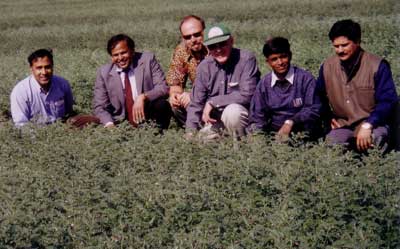Western Australia
July 21, 2004
Western Australia could miss out on a $400 per hectare crop,
while the north eastern and central grainbelt could go without a
legume rotation if chickpea breeding is centralised.
According to University of
Western Australia researcher, Jens Berger, chickpea
varieties bred for more benign, long growing seasons, such as at
Tamworth, New South Wales, could be limited to under
0.5 tonne per hectare yields
in low rainfall environments such as at Merredin, Western
Australia.
“Chickpea is one of Australia’s highest earning crops, but
Western Australia's production could be threatened by a shift in
breeding focus. Early plant vigour and phenology can differ
tremendously across the broad range of genetics assembled in
Australia to deliver variable yield performance.
“Most Australian-bred cultivars are too late for optimal
productivity in the short season Mediterranean-type
environments, typical of WA’s northern wheatbelt,” Dr Berger
said.
In an Australian Centre for
International Agricultural Research (ACIAR) funded project,
the Centre for Legumes in
Mediterranean Agriculture (CLIMA) recently finalised two
years of studies on 72 chickpea lines across sites at
Merredin,
Western Australia,
Minnipa, South Australia, Walpeup, Victoria, Tamworth, New South
Wales and Warwick, Queensland.
While lines well-adapted to short-season Mediterranean
environments generally performed consistently across the
country, most Australian-bred
cultivars were productive
only in benign environments.
For a given genotype, yield varied from 0.2 to 3.0 tonnes per
hectare, depending upon the environment, indicating significant
genotype by environment interaction.
According to Dr Berger, this disparity reflects the need for
specific, targeted breeding and selection to cater to
Australia’s broad range of chickpea growing environments.
“Apart from ascochyta blight resistance, few chickpea
characteristics are required uniformly across the country.
“Diverse needs are difficult to meet
in a single, centralised breeding program, where
prevailing environmental and soil conditions would create
selection pressure unable to produce lines offering traits
necessary for other areas,” Dr Berger said.
Centralising chickpea breeding in eastern Australia defied this
logic, according to CLIMA Director, Kadambot Siddique.
“The early
generations following hybridisation must be advanced in the
target environment to correctly evaluate for desired traits and
develop superior cultivars.
“Responsiveness of chickpea lines to the day length and
temperature of a
Western Australian
environment
differed significantly from Tamworth, New South Wales and
Horsham, Victoria.
“More than one third of Western Australian growers have already
acknowledged the importance of locally developed varieties by
supporting CLIMA’s kabuli chickpea initiatives through the
Council of Grain Grower Organisations (COGGO).
“We commend
their foresight and hope desi chickpea, potentially a major
industry in
Western Australia,
can also benefit from such local development,” Professor
Siddique said.

CLIMA Director Professor Kadambot Siddique (left), UWA
Researcher Dr Jens Berger (3rd from left) and UWA
Adjunct Professor Neil Turner (3rd from right)
evaluating chickpea performance with collaborating scientists
from the Indian Agricultural Research institute. |